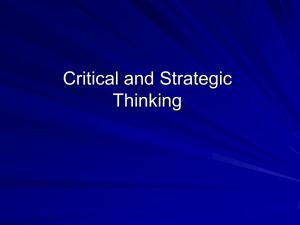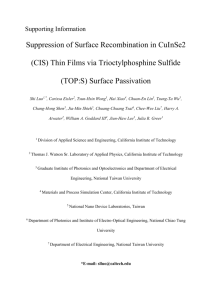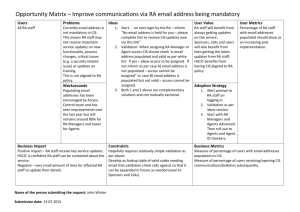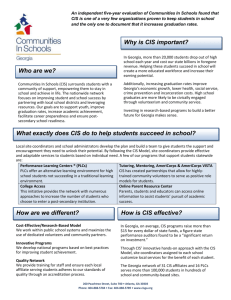Topic 11 “Selecting the Best Alternative Strategy. WSM Method”
advertisement
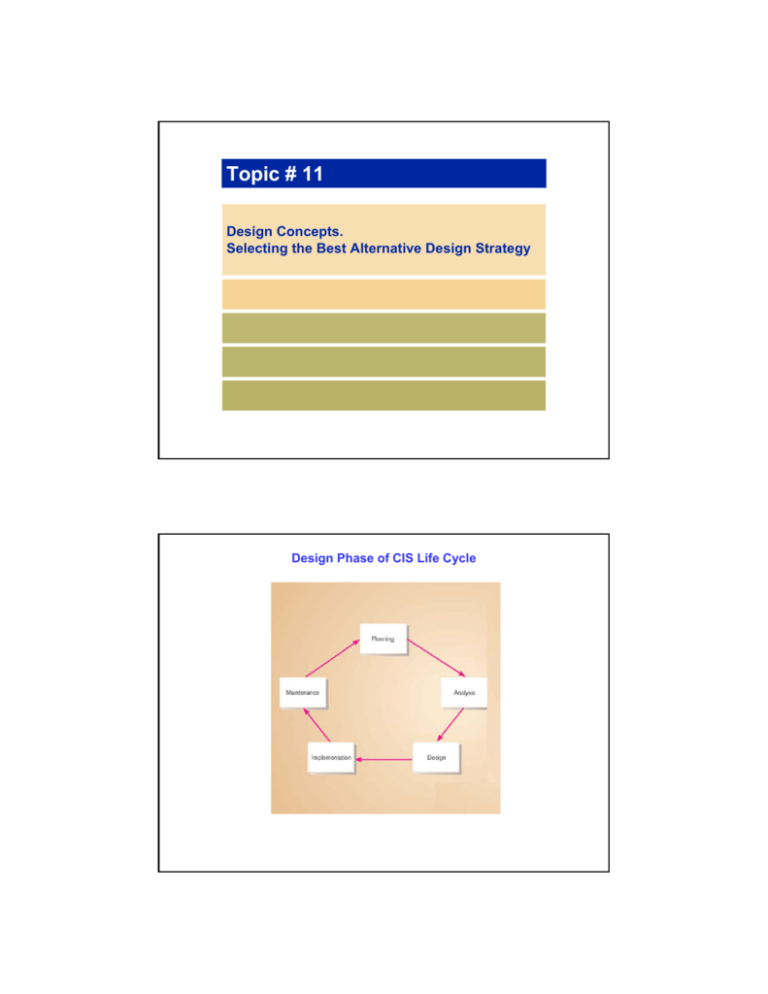
Topic # 11 Design Concepts. Selecting the Best Alternative Design Strategy Design Phase of CIS Life Cycle Design Design - is a meaningful engineering representation of something that must be built (i.e. for engineers and/or developers). In CIS context, CIS Design focuses on the following main areas: 1. Architecture architectural design defines the relationships between major structural elements of the CIS 2. Components component-level design transforms structural elements of the CIS architecture into a procedural description of CIS components (based on control specifications, process specifications and state transition diagram). 3. Data data design transforms the information domain model into the particular data structures 4. Interfaces interface design describes how the CIS communicates within itself, with other systems in the environment, and with users Design Model as a Bridge Analysis Design Development FROM Analysis Model TO Design Model Class objects and processing units Analysis model Maps into (DOs, DFDs, ERDs, STDs, activity diagrams, use cases, etc.) Design model (architecture, components, data, interfaces) Software modules CIS Design: Fundamental Concepts 1. Abstraction 2. Architecture 3. Patterns 4. Modularity 5. Information Hiding 6. Functional Independence 7. Refinement 8. Re-factoring data, procedure, control the overall structure of the software ”conveys the essence” of a proven design solution (best cases, re-usable designs)) compartmentalization of data and function controlled interfaces single-minded function and low coupling elaboration of details for all abstractions a reorganization technique that simplifies the design 1.1. Data Abstraction (abstractive data models not actual objects) door manufacturer model number type swing direction inserts lights type number weight opening mechanism implemented as a data object Abstraction - allows designers to simplify a problem and focus on solving a problem without being concerned about irrelevant lower level details • 1.2. Procedural Abstraction (solution algorithms) open details of enter algorithm implemented with a "knowledge" of the object that is associated with “enter algorithm” Abstraction - allows designers to simplify a problem and focus on solving a problem without being concerned about irrelevant lower level details • (en example: procedural abstraction: a subroutine – a named sequence of actions and events) • 2. Architecture: Webster CIS - A Structural Design (system, subsystems, and component design) System Level System (Webster System) A subsystem GUI Databases Security Level of Subsystems (Domains) …... (Databases, GUI, Security, HELP, etc.) A component Tables (DOs) Macros Forms Reports Queries …... Level of Elements or Components (tables, forms, queries, reports, macros and modules, …) A detail (attribute) ID FN LN DOB YOA Status … …... Level of Sub-elements, Details (for ex., attributes) (ID, First Name, Last Name, DOB, YOA, status, …) 3. Patterns (Reusability of previous designs and design solutions) Design Pattern Template: Pattern name Intent Also-known-as Motivation Applicability Structure Participants Collaborations Consequences Related patterns describes the essence of the pattern in a short but expressive name describes the pattern and its functions lists any synonyms for the pattern provides an example of the problem notes specific design situations in which the pattern is applicable describes the classes that are required to implement the pattern describes the responsibilities of the classes that are required to implement the pattern describes how the participants collaborate to carry out their responsibilities describes the “design forces” that affect the pattern and the potential trade-offs that must be considered when the pattern is implemented cross-references related design patterns *) Patterns-based SE, patterns-based analysis, patterns-based software development, pattern languages, etc. – still a lot of research needed, a lot of Ph.D. dissertations Patterns: Analogy in Construction Engineering (reusability of previous designs and design solutions) Example of Highly Reusable CIS Selecting the Best Alternative Design: Selecting the best alternative design involves at least two basic steps: a) generating a comprehensive set of alternative design strategies, and b) selecting the one that is most likely to result in the desired information system, given all of the organizational, economic, and technical constrains. “One Design Strategy” Case: Disadvantages 1) 2) 3) NO GUARANTEE that the best, correct, or even an adequate system for the situation is being developed or purchased. This is not obvious because it is unclear if other alternatives were considered, and if they were, those present cannot see why the one choice won out. ONE VENDOR – ONE PRICE. If the one strategy is chosen because only one vendor is used, there are no benefits from having multiple vendors compete for an RFP. For example, the vendor has no incentive to keep his price as low as possible. NO PUBLIC DETAILED SPECIFICATIONS. Without the detailed, public systems specifications that are part of a competitive bid process, there is not likely to be much in the way of written documentation to refer back to if the vendor does not fulfill his promises. If the analysts present only one design strategy during the oral presentation to the project steering committee or client, the recommendations are likely to be (at worst) rejected, or (at best) accepted with great skepticism. It is also possible that those present at the meeting will start to generate alternatives, each representing that person’s position. The meeting will quickly deteriorate since a fair assessment of ad hoc alternatives cannot be done within the limits of a meeting. In any event, this is not a good way to begin the development of an information system (or build a career). Design Strategy • The primary deliverables from generating alternative design strategies and selecting best one are: (1) at least three (better – 5) substantially different system design strategies, (2) a design strategy judged most likely to lead to the most desirable information system, and (3) A Baseline Product Plan for turning the most likely design strategy into a working information system. Ex: 1) You want to buy a house. What are your alternative approaches? 2) You want to replace...a computer, a furnace, a water-heater, carpeting, roofing, etc. Your approaches? Generating Alternatives Issues to Consider in Generating Alternatives • System analysts should consider at least two cases: (1) which design strategies would minimally satisfy objectives and not violate constraints, and (2) which design strategies would meet or exceed objectives with minimal violation of constraints. There are many possible design strategies between these two extreme positions. • Analysts should generate three alternatives because three alternatives can represent both ends and the middle of a continuum of potential solutions. Ex: Expensive High Quality Middle Cheap Average Low Quality Selection Criteria Criteria to be used: The following selection criteria can be used in order to select best alternative: (1) cost, (2) functionality, (3) vendor support, (4) viability of vendor, (5) flexibility, (6) documentation, (7) response time, and (8) ease of installation. Selecting the Most Likely Alternative Selecting Most Likely Alternative • The method for evaluating alternatives is called Weighting and Scoring. (1) Create a table with (a) requirements, (b) constraints, and (c) alternative solutions. (2) Weights for requirements and constraints (3) Ratings for alternatives (rating of 5 indicates that the alternative meets or exceeds the requirement or clearly abides by the constraint). Criteria Weight Alt A Alt B Alt C Rating Score Rating Score Rating Score Requirements Real-time data entry 10 5 50 5 50 5 50 Auto re-order 10 3 30 5 50 5 50 Real-time data query 10 1 10 3 30 5 90 130 50 150 Constraints Development costs 25 5 125 4 100 3 75 Hardware costs 25 5 125 4 100 4 100 Time to operation 15 5 75 4 60 3 45 Ease of training 5 5 25 3 15 5 Total 100 25 350 275 245 440 405 395 Weighted Scoring Model Steps WSM main steps: 1. First identify criteria important to the project selection process 2. Then assign weights (percentages) to each criterion so they add up to 100% 3. Then assign BY YOURSELF scores to each criterion for each project (based on calculated numeric values of NPV, ROI, IRR, PTP, etc.) 4. Multiply the scores by the weights and get the total weighted scores Important note: In many cases, scores for all under-review projects should add up to 100 points. New PC Computer A Computer B Computer C Topic # 11 WSM Method and Selecting the Best Alternative Design Strategy: In-Classroom Exercise

